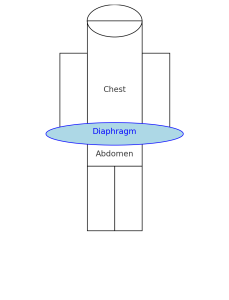The diaphragm, a muscular structure that separates the chest cavity from the abdominal cavity, plays a crucial role in breathing. During pregnancy, a woman’s body undergoes numerous physiological changes that can also affect the diaphragm. After childbirth, it may take some time for the diaphragm to regain its normal function and position. This article explores the impact of pregnancy on the diaphragm and presents scientific insights on this topic.
Anatomy and Function of the Diaphragm

The diaphragm is a thin but strong muscle that spans across the body. It consists of a central tendon and muscle tissue that attaches at the edges. The main function of the diaphragm is to support the lungs in breathing.
The Mechanism of Breathing
Breathing is a two-phase process, consisting of inhalation (inspiration) and exhalation (expiration).
Inhalation (Inspiration):
- Diaphragm Contraction: During inhalation, the diaphragm contracts and moves downward. This increases the space in the chest cavity, and the pressure in the lungs becomes lower than the atmospheric pressure.
- Airflow into the Lungs: This pressure difference causes air to flow into the lungs to equalize the pressure. The lungs expand, and oxygen enters the alveoli (air sacs), where gas exchange occurs.
Exhalation (Expiration):
- Diaphragm Relaxation: During exhalation, the diaphragm relaxes and returns to its dome-shaped resting position. The space in the chest cavity decreases, and the pressure in the lungs rises above atmospheric pressure.
- Air Expulsion from the Lungs: This pressure difference causes air to be expelled from the lungs, removing carbon dioxide, a waste product of cellular metabolism, from the body.
Interactions with Other Respiratory Muscles
Although the diaphragm is the primary muscle of respiration, other muscles also assist in breathing, especially during deep or strenuous breathing. These include:
- Intercostal Muscles (Between the Ribs): These muscles help to raise and lower the chest, increasing the volume of the chest cavity.
- Abdominal Muscles: These muscles aid in exhalation, particularly during physical exertion or coughing.
- Accessory Muscles: Muscles in the neck and upper chest can also be activated to increase the volume of air intake.
The Diaphragm and Breathing Efficiency
A well-functioning diaphragm is crucial for efficient breathing. Strong diaphragmatic muscles contribute to deep and effective breathing, optimizing the body’s oxygen supply. Regular breathing exercises and physical activity can help improve the strength and endurance of the diaphragm.
Physiological Changes of the Diaphragm During Pregnancy
During pregnancy, the uterus enlarges and occupies more space in the abdominal cavity. This leads to an upward displacement of the diaphragm by about 4 cm. This displacement affects the breathing mechanics as the diaphragm operates in a shortened position. Additionally, the lung volume decreases, which is compensated by an increase in breathing frequency and depth.
Effects After Childbirth
After childbirth, the body needs time to recover from the changes of pregnancy. This also applies to the diaphragm. Here are some of the most common effects on the diaphragm after childbirth:
- Diaphragm Displacement: After childbirth, the diaphragm gradually returns to its normal position. This can take several weeks to months, depending on individual factors such as uterine involution and the mother’s overall physical condition.
- Breathing Problems: Some women report breathing difficulties after childbirth, which may be due to a temporary dysfunction of the diaphragm. This is often due to the exhaustion of the respiratory muscles that were more heavily used during pregnancy.
- Muscle Tone and Strength: The diaphragm may temporarily lose muscle tone and strength after childbirth. Exercises to strengthen the diaphragm and the entire core can help restore its function.
Recommendations for Rehabilitation
To strengthen the diaphragm after pregnancy and improve breathing function, the following measures can be recommended:
- Breathing Exercises: Deep breathing and diaphragmatic breathing can help restore the muscle strength of the diaphragm.
- Physical Therapy: Specialized physical therapy can help train the respiratory muscles and promote overall physical recovery.
- Exercise and Sports: Light physical activities and targeted exercises that strengthen the core can also be beneficial.
Postpartum Exercises to Strengthen the Diaphragm and Respiratory Muscles
After pregnancy, it can be especially important to do targeted exercises to strengthen your diaphragm and respiratory muscles. These exercises help improve your breathing function and support your overall recovery. Here are some effective postpartum exercises you can try:
- Diaphragmatic Breathing
- How to do it: Lie on your back or sit comfortably. Place one hand on your belly and the other on your chest. Inhale deeply through your nose, allowing your belly to rise while keeping your chest as still as possible. Exhale slowly through your mouth, letting your belly fall.
- Effect: This exercise helps activate and strengthen your diaphragm and promotes deeper, more efficient breathing.
- Cat-Cow Stretch
- How to do it: Start on all fours, with your hands directly under your shoulders and knees under your hips. Inhale and lift your head and tailbone, allowing your belly to drop (cow position). Exhale and round your back, pulling your belly in and lowering your head (cat position). Repeat this movement in rhythm with your breathing.
- Effect: This exercise improves the flexibility of your spine and promotes the mobility of your diaphragm.
- Pelvic Tilts
- How to do it: Lie on your back with your knees bent and feet flat on the floor. Tighten your abdominal muscles and tilt your pelvis slightly upward, so your lower back touches the floor. Hold for a few seconds and then return to the starting position.
- Effect: This exercise strengthens your abdominal and pelvic floor muscles, which are closely connected to the diaphragm function.
- Bridge Pose
- How to do it: Lie on your back with your knees bent and feet flat on the floor. Slowly lift your pelvis until your thighs and back form a straight line. Hold the position for a few breaths and then slowly lower your pelvis back down.
- Effect: This exercise strengthens your abdominal, gluteal, and back muscles and promotes better breathing mechanics.
- Child’s Pose
- How to do it: Kneel on the floor and sit back on your heels. Bend forward, stretching your arms out in front of you, and rest your forehead on the floor. Breathe deeply in and out, letting your belly expand with each breath.
- Effect: This position relaxes your body and allows for deep breathing, which relieves and stretches your diaphragm.
- Pursed Lip Breathing
- How to do it: Sit comfortably and inhale slowly through your nose. Purse your lips as if you are going to blow out a candle and exhale slowly through your mouth. Extend the exhalation to strengthen your respiratory muscles.
- Effect: This technique helps you train your respiratory muscles and improve breathing efficiency.
Conclusion
After pregnancy, it’s important to specifically strengthen your diaphragm and respiratory muscles to optimize breathing function and support your recovery process. The exercises listed above are easy to perform and can help improve your muscle strength and flexibility. Try to integrate these exercises regularly into your daily routine, and consult a physical therapist or doctor if needed.
The diaphragm (breathing), abdominal, pelvic floor, and deep back muscles are closely connected and necessary for a stable core. After pregnancy, all four parts need to be reactivated, strengthened, and returned to their physiological position.
Read my articles on:
References:
- LoMauro, A., & Aliverti, A. (2015). Respiratory physiology of pregnancy: Physiology masterclass. Breathe, 11(4), 297-301.
- Di Marco, F., et al. (2019). Postpartum recovery of respiratory function: a study on respiratory mechanics and diaphragm function. Journal of Maternal-Fetal & Neonatal Medicine, 32(8), 1312-1319.
- Liu H, Wiedman CM, Lovelace-Chandler V, Gong S, Salem Y. Deep Diaphragmatic Breathing-Anatomical and Biomechanical Consideration. J Holist Nurs. 2024 Mar;42(1):90-103. doi: 10.1177/08980101221149866. Epub 2023 Feb 3. PMID: 36734111.

Sonja ist Ernährungswissenschaftlerin und promovierte Epidemiologin mit langjähriger Erfahrung in der Gesundheitsforschung. Seit der Geburt ihrer beiden Kinder 2019 und 2023 beschäftigt sie sich intensiv mit dem Thema Rückbildung und der Thematik, wie man wieder einen gesunden und schönen Körper mit stabiler Mitte nach der Schwangerschaft bekommen kann. Sie möchte Euch helfen, nach der Schwangerschaft wieder fit zu werden!